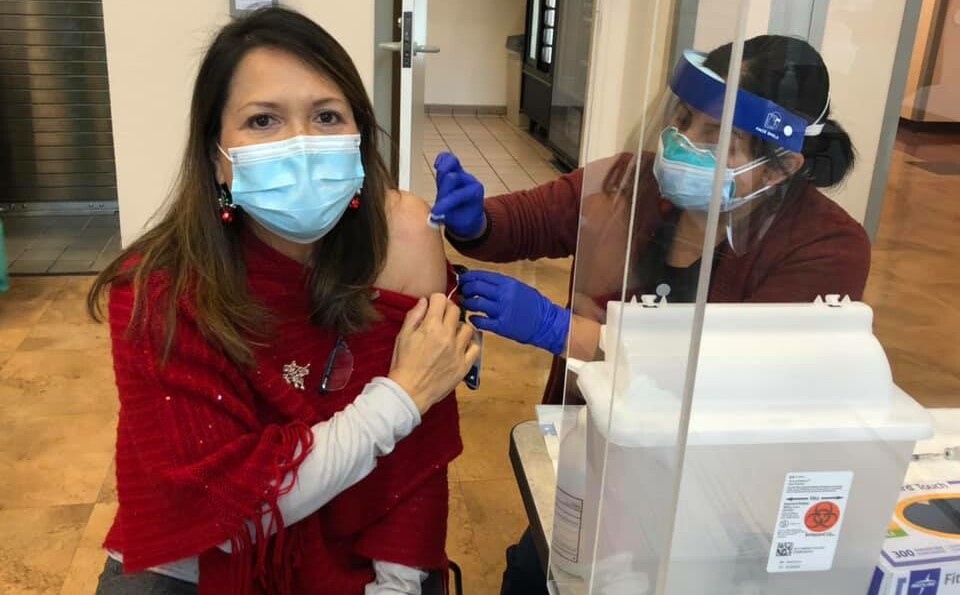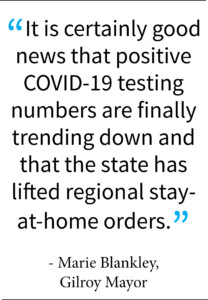Santa Clara County goes into ‘purple tier’ to open economy with fewer restriction
Experts say strain on ICUs will lift significantly in the next several weeks

By Marty Cheek
Gov. Gavin Newsom lifted the stay-at-home order for all regions across California starting Jan. 25. Immediately after the announcement Santa Clara County began allowing outdoor dining, personal care services, and professional, collegiate and adult and youth sports to resume with required modifications.
The county continues to experience an alarming rate of COVID-19 transmission, and hospital and intensive care unit capacities remain extremely limited. As of Friday Jan. 29, Gilroy has had 6,594 residents (nearly 12 percent of the city) listed as confirmed cases of the virus. Medical staff, including at St. Louise Regional Hospital, continue to be stretched. Through the month of January, new daily confirmed county cases continue to be much higher than the previous summer peak.
 Despite the state opening its restrictions, the danger the coronavirus poses to the public has not subsided, emphasized Santa Clara County Health Officer and Director of Public Health for the county Dr. Sara Cody. She urges businesses, entities, and residents to continue exercising caution even as certain restrictions are lifted by the state.
Despite the state opening its restrictions, the danger the coronavirus poses to the public has not subsided, emphasized Santa Clara County Health Officer and Director of Public Health for the county Dr. Sara Cody. She urges businesses, entities, and residents to continue exercising caution even as certain restrictions are lifted by the state.
The purple tier (widespread risk) of the state’s Blueprint for a Safer Economy opens the economy locally with some additional local restrictions remaining in place including the county’s mandatory travel restriction requiring a 10-day quarantine for most people who travel into the county from more than 150 miles away.
“Santa Clara County continues to experience very high rates of COVID-19 transmission,” Cody said in a Jan. 25 press release. “Our collective actions to date have saved lives and helped protect our healthcare system from collapse. I encourage all residents to remain vigilant, wear a mask anytime you leave your home, maintain a distance of at least six feet from anyone outside your household, and get vaccinated when it is your turn.”
Gilroy Mayor Marie Blankley is optimistic about Newsom’s announcement and expressed her hope the county will see a decline in cases and deaths.
“It is certainly good news that positive COVID-19 testing numbers are finally trending down and that the state has lifted regional stay-at-home orders,” she said.
 In Santa Clara County, the resulting purple tier is not where she would like to be. But if the communities keep this trend going, then Gilroy and other cities may soon see more restrictions lifted, she said.
In Santa Clara County, the resulting purple tier is not where she would like to be. But if the communities keep this trend going, then Gilroy and other cities may soon see more restrictions lifted, she said.
“For now, let’s support what we can by patronizing businesses that are now open and continuing to properly wear masks and social distance,” she said.
Going back to the purple tier is a lifeline for many businesses that are holding on by a thread, said Christina Turner, city manager for Morgan Hill.
“The back and forth of opening and closing indoors and outdoors has been extremely difficult,” she said.
 She encourages members of the South Valley community to continue to remain vigilant and stay indoors as much as possible to reduce the potential spread of COVID-19. She also encourages everyone to wear a mask, maintain physical distance and not gather indoors.
She encourages members of the South Valley community to continue to remain vigilant and stay indoors as much as possible to reduce the potential spread of COVID-19. She also encourages everyone to wear a mask, maintain physical distance and not gather indoors.
“As the vaccine continues to be more broadly distributed, there will be more reason for hope,” she said. “There is a light at the end of the tunnel.”
Changes effective Jan. 25 are all subject under mandatory directives that can be found on the county’s website. They include:
- Outdoor dining may resume, subject to the mandatory directive for dining. Indoor dining remains prohibited. Bars, breweries, distilleries, and pubs may serve alcohol only outdoors and only in the same transaction as a meal.
- Personal care services may resume indoors and outdoors.
- Professional and collegiate sports may resume.
- Adult recreational sports activities may resume.
- Youth sports may resume subject to the state’s guidance applicable to those activities, as well as the county’s mandatory directive for programs serving children and youth.
Most businesses that are allowed to open indoor operations to the public must limit capacity of their publicly accessible space to 20 percent. The county’s mandatory directive on capacity limitations has been updated to reflect current openings and closings.
Outdoor gatherings with up to three households are now allowed for any purpose. Larger outdoor gatherings with up to 200 people are allowed only for political, religious, or ceremonial purposes, or as otherwise specifically allowed by the state. Indoor gatherings of any kind remain prohibited.
The county’s mandatory directive on travel, which requires most people who travel into the county from more than 150 miles away to quarantine for 10 days upon their arrival, is still in effect.
The county’s mandatory directive for lodging facilities is still in effect. Lodging facilities may not provide lodging services for non-essential purposes, such as tourism, recreational, or leisure purposes. Non-essential travel should be avoided, especially in light of new variants of COVID-19 that are circulating globally and in the United States.
The reversal by state public health officials of the stay-at-home orders was abrupt, prompting accusations by critics that Newsom made the decision based on politics over medical science. The rates of COVID-19 cases still remain high in the aftermath of the holidays.
Newsom defended the decision to open the state by saying models showed the strain on ICUs at hospitals will be lifting significantly in the next several weeks.
By Feb. 21, ICU capacity is projected to reach 30.3 percent across California, with 33.3 percent of space available in Southern California, 22.3 percent in the San Joaquin Valley and 25 percent in the Bay Area.
In other COVID-19 news, Santa Clara County Jan. 26 expanded vaccination to residents 65 and older.
“As the vaccine becomes available to more residents, the county continues its commitment to equity and ensuring access for our communities most at risk of contracting COVID-19,” said Dr. Jennifer Tong, Associate Chief Medical Officer for the County of Santa Clara Health System.
In addition to mass vaccination sites at the Santa Clara County Fairgrounds, Berger Drive in San Jose, and the Mountain View Community Center, the county has capacity to vaccinate hundreds of residents per day at several Valley Health Center locations, including up to 600 people per day in Gilroy.
The ability to quickly expand access in Santa Clara County depends on the supply of vaccine. Only 20,125 additional first doses of vaccine the week of Jan. 24-30 was allocated to the County Health System and other vaccine providers, far fewer doses than health systems in the county have capacity to provide.
